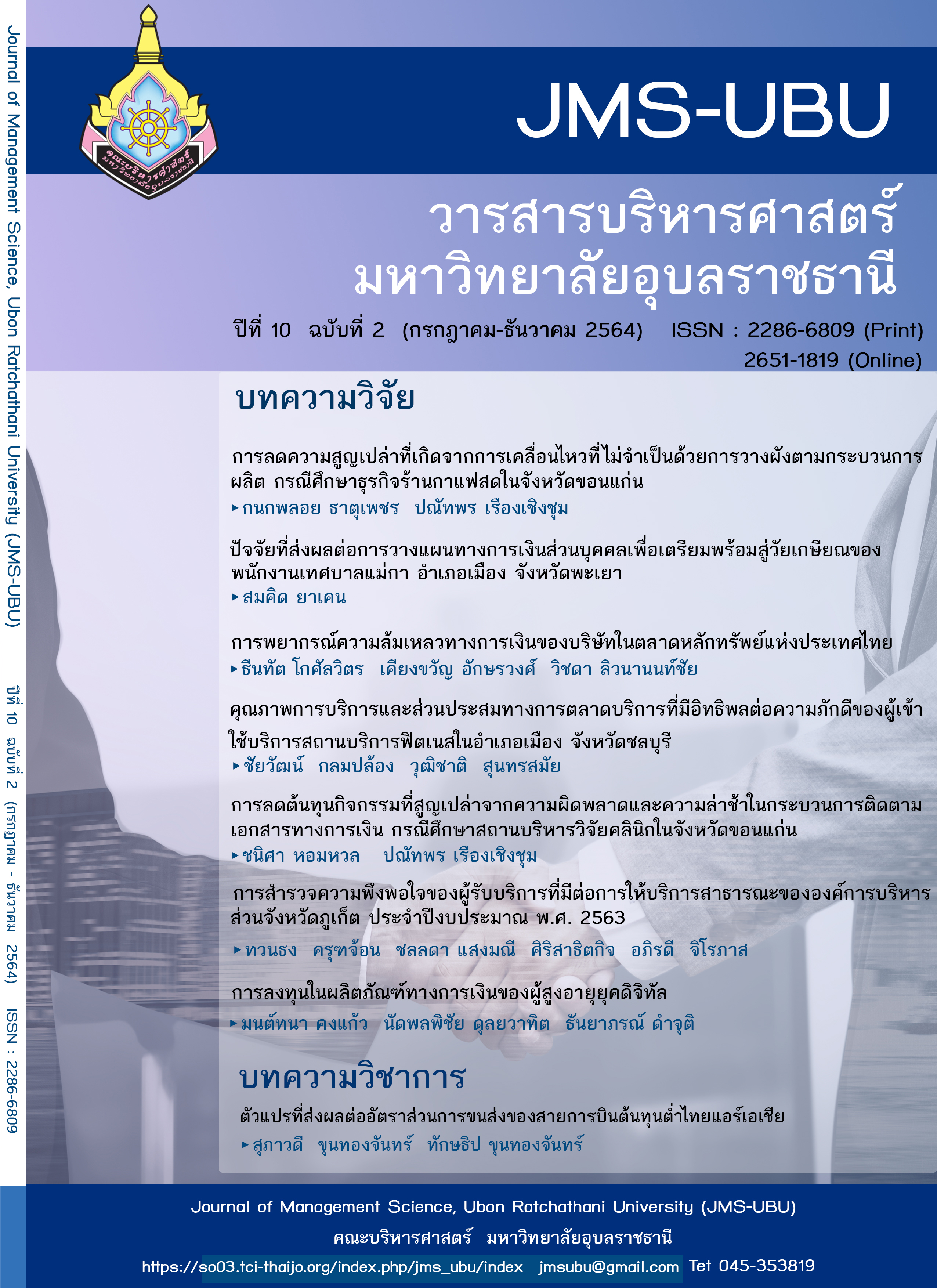คุณภาพการบริการและส่วนประสมทางการตลาดบริการที่มีอิทธิพลต่อความภักดีของผู้เข้าใช้บริการสถานบริการฟิตเนสในอำเภอเมือง จังหวัดชลบุรี
Main Article Content
บทคัดย่อ
การวิจัยนี้มีวัตถุประสงค์เพื่อศึกษาปัจจัยที่มีอิทธิพลต่อระดับความภักดีของผู้เข้าใช้บริการสถานบริการฟิตเนส ประกอบด้วย ระดับคุณภาพการบริการ และส่วนประสมทางการตลาดบริการ การวิจัยนี้เป็นการวิจัยเชิงปริมาณ ใช้แบบสอบถามเป็นเครื่องมือในการเก็บรวบรวมข้อมูล มีกลุ่มตัวอย่างคือ ผู้ที่เข้าใช้บริการและเป็นสมาชิกของสถานบริการฟิตเนสในเขตอำเภอเมือง จังหวัดชลบุรี จำนวน 400 คน สถิติที่ใช้ในการวิเคราะห์คือ การวิเคราะห์การถดถอยเชิงพหุคูณ
ผลการศึกษาพบว่ากลุ่มตัวอย่างมีระดับความคิดเห็นเรื่องคุณภาพบริการ ในด้านความเชื่อถือ การตอบสนองและความสะดวกทางกายภาพ อยู่ในระดับที่เห็นด้วยมาก ด้านความเอาใจใส่อยู่ในระดับเห็นด้วยปานกลาง และด้านความเชื่อมั่นอยู่ในระดับเห็นด้วยน้อย เรื่องส่วนประสมทางการตลาดบริการ ทั้ง 7 ด้าน อยู่ในระดับเห็นด้วยมาก และความภักดี ในด้านพฤติกรรมการซื้อซ้ำ พฤติกรรมการบอกต่อ ความตั้งใจซื้อ ความอ่อนไหวต่อราคา และพฤติกรรมการร้องเรียนอยู่ในระดับเห็นด้วยมาก และผลการทดสอบสมมติฐานพบว่า คุณภาพการบริการในด้านความน่าเชื่อถือ ด้านการตอบสนอง ด้านความเอาใจใส่ และด้านความสะดวกทางกายภาพ มีอิทธิพลต่อความภักดีของผู้เข้าใช้บริการสถานบริการฟิตเนส และส่วนประสมทางการตลาดบริการในด้านการบริการ ด้านราคา ด้านสถานที่ในการให้บริการ ด้านการส่งเสริมการตลาด และด้านบุคคลและพนักงาน มีอิทธิพลต่อความภักดีของผู้เข้าใช้บริการสถานบริการฟิตเนส และคุณภาพการบริการมีอิทธิพลต่อความภักดีของผู้เข้าใช้บริการสถานบริการฟิตเนส โดยมีส่วนประสมทางการตลาดบริการเป็นตัวแปรส่งผ่าน
Downloads
Article Details
เอกสารอ้างอิง
กรมธุรกิจการค้า. (2563) แหล่งค้นหาข้อมูลนิติบุคคลและประเภทธุรกิจในประเทศไทย. สืบค้นจาก
https://datawarehouse.dbd.go.th/index
กรมพัฒนาธุรกิจการค้า. (2562). ธุรกิตฟิตเนส บทวิเคราะห์ธุรกิจประจำเดือน พฤษภาคม 2562. สืบค้นจาก
https://www.dbd.go.th/download/document_file/Statisic/2562/T26/T26_201905.pdf
กีรติ บันดาลสิน. (2558). การรับรู้คุณภาพบริการที่ส่งผลต่อความจงรักภักดีในการใช้บริการของลูกค้าธนาคารออมสิน
สาขาสำนักราชดำเนิน. (วิทยานิพนธ์ปริญญามหาบัณฑิต). มหาวิทยาลัยศิลปากร, บัณฑิตวิทยาลัย.
จิรศักดิ์ ชาพรมมา. (2560). ปัจจัยที่มีอิทธิพลต่อการตัดสินใจใช้บริการฟิตเนสเซ็นเตอร์ที่เปิดให้บริการ 24 ชั่วโมง ของ
ผู้บริโภคในเขตกรุงเทพมหานคร. (การค้นคว้าอิสระปริญญามหาบัณฑิต). มหาวิทยาลัยธรรมศาสตร์, คณะพาณิชยศาสตร์และการบัญชี.
ไชยพศ รื่นมล. (2558). ปัจจัยที่ส่งผลต่อความจงรักภักดีของผู้ใช้บริการธุรกิจคาร์แคร์ ในกรุงเทพมหานคร. (วิทยานิพนธ์ปริญญามหาบัณฑิต). มหาวิทยาลัยศิลปากร, คณะวิทยาการจัดการ, สาขาวิชาการประกอบการ.
ณักษ์ กุลิสร์, ภัทราพร จิตสร้างบุญ และศุภิณญา ญาณสมบูรณ์. (2557). คุณภาพการให้บริการ และความคุ้มค่าที่มี
อิทธิพลต่อความภักดีของนิสิตปริญญาโท หลักสูตรบริหารธุรกิจมหาบัณฑิต มหาวิทยาลัยศรีนครินทรวิโรฒ. วารสารสังคมศาสตร์ มหาวิทยาลัยศรีนครินทรวิโรฒ. 17(มกราคม-ธันวาคม), 83-93.
ณัฐจิรา อิ่มวิเศษ. (2558). ปัจจัยที่มีความสัมพันธ์ต่อความภักดีในตราสินค้าเครื่องใช้ไฟฟ้าสตาร์เวลล์ในกรุงเทพมหานคร. (วิทยานิพนธ์ปริญญามหาบัณฑิต). มหาวิทยาลัยศิลปากร, คณะวิทยาการจัดการ, สาขาวิชาประกอบการ.
ณัฐพร ดิสนีเวทย์. (2559). ปัจจัยที่ส่งผลต่อความภักดี ของลูกค้าที่มีต่อตราสินค้าร้านคาเฟ่ขนมหวานในห้างสรรพสินค้า. (การค้นคว้าอิสระปริญญามหาบัณฑิต). มหาวิทยาลัยกรุงเทพ, คณะมนุษยศาสตร์และการจัดการการท่องเที่ยว, สาขาวิชาการจัดการอุตสาหกรรมการบริการและการท่องเที่ยว.
เดอะสแตนดาร์ดทีม (2561). ผลสำรวจชี้ คนไทยมีแนวโน้มใส่ใจสุขภาพมากขึ้น. สืบค้นจาก
https://thestandard.co/aia-sharing-a-life-charity/
ปราโมทย์ ประสาทกุล และปัทมา ว่าพัฒนวงศ์. (2558). อัตรการเจ็บป่วยและการเสียชีวิตของคนไทย. สืบค้นจาก
http://peunemoloyment.blogspot.com
วุฒิชาติ สุนทรสมัย. (2555). การวิจัยการตลาดและระบบสารสนเทศทางการตลาด (พิมพ์ครั้งที่ 2). กรุงเทพฯ: สมาคม
ส่งเสริมเทคโนโลยี ไทย-ญี่ปุ่น.
วุฒิชาติ สุนทรสมัย. (2560). พฤติกรรมผู้บริโภค. คณะการจัดการและการท่องเที่ยว: มหาวิทยาลัยบูรพา.
สมบัติ ธำรงสินถาวร. (2561). การตลาดเชิงสัมพันธ์ : แนวคิดพื้นฐานสำหรับการทำวิจัย. กรุงเทพฯ: พิมพ์ทันใจ.
สำนักงานกองทุนสนับสนุนการสร้างเสริมสุขภาพ. (2555). การเจ็บป่วยและการตาย. สืบค้นจาก
https://www.thaihealth.or.th/Content/20342-การเจ็บป่วยและการตาย.html
สิทธา พงษ์พิบูลย์ และ ฉัตรชัย มะสุนสืบ. (2555). การบาดเจ็บอันเกิดจากการใช้บริการสถานประกอบกิจการด้าน
การออกกำลังกายเพื่อสุขภาพ. วารสารวิทยาศาสตร์การกีฬาและสุขภาพ. 13(1), 104–118.
หัทญา คงปรีพันธุ์. (2557). คุณภาพการให้บริการที่ส่งผลต่อความจงรักภักดีของลูกค้าเปรียบเทียบระหว่างธนาคารกรุงไทย จำกัด (มหาชน) กับธนาคารกรุงเทพ จำกัด (มหาชน) ในเขตอำเภอเมือง จังหวัดปทุมธานี. (การค้นคว้าอิสระปริญญามหาบัณฑิต). มหาวิทยาลัยเทคโนโลยีราชมงคลธัญบุรี, คณะบริหารธุรกิจ, สาขาการจัดการทั่วไป.
อติชาต มีเจริญ. (2561). การรับรู้ส่วนประสมทางการตลาดที่ส่งผลต่อความพึงพอใจของผู้ใช้บริการสถานฟิตเนสใน
อำเภอเมือง จังหวัดฉะเชิงเทรา. (งานนิพนธ์ปริญญามหาบัณฑิต). มหาวิทยาลัยบูรพา, คณะการจัดการและการท่องเที่ยว, สาขาวิชาการจัดการวิสาหกิจขนาดกลางและขนาดย่อม.
Baron, R. M., & Kenny, D. A. (1986). The moderator-mediator variable distinction in social psychological
research: Conceptual, strategic and statistical considerations. Journal of Personality and Social
Psychology, 51(6), 1173-1182.
Bloemer, J., Ruyter, K. D., & Wetzels, M. (1999). Linking perceived service quality and service loyalty: A multi- dimensional perspective. European Journal of Marketing, 33(11/12), 1082-1106.
Booms, B., & Bitner, M. J. (1981). Marketing strategies and organizational structures for service firms.
In J., H. Donnelly & W. R. George, (Eds.). Marketing of Services (pp, 47-51). Chicago: American
Marketing Association.
Caruana, A. (2002). Service loyalty : The effects of service quality and the mediating role of customer satisfaction. European Journal of Marketing, 36(7/8), 811-828.
Cochran, W. G. (1977). Sampling Techniques. 3rd ed. New York: John Wiley and Sons Inc.
Cronbach, L. J. (1951). Coefficient alpha and the internal structure of tests. Psychometrika, 16(3), 297-334.
Dick, A. S., & Basu, K. (1994). Customer loyalty: Toward an integrated conceptual framework. Journal of the
Academy of Marketing Science, 22(2), 99-113.
Hair, J. F., Black, W. C., Babin, B. J., & Anderson, R. E. (2010). Multivariate data analysis (7th ed.). Upper
Saddle River, NJ.: Prentice-Hall.
Jacoby, J., & Kyner, D. B. (1973). Brand loyalty vs. repeat purchasing behavior. Journal of Marketing
Research, 10(1), 1-9.
Lewis, R. C., & Booms, B. H. (1983). The marketing aspects of service quality. In L. Berry, G. Shostack & G. Upah (Eds). Emerging Perspectives on Services Marketing. American Marketing Association.
Chicago, IL.
McCarthy, E. J. (1960). Basic Marketing: A Managerial Approach. Homewood, IL: Richard D. Irwin, Inc. Muala, A. A., & Qurneh, M. A. (2012). Assessing the relationship between marketing mix & loyalty through tourist satisfaction in Jordan curative tourism. American Academic & Scholarly Research
Journal, 4(2), 7-23.
Othman, B., Harun, A., Rashid, W., & Ali, R. (2019). The impact of Umrah service quality on customer
satisfaction towards Umrah travel agents in Malaysia. Management Science Letters, 9(11),
-1772.
Parasuraman, A., Zeithaml, V. A., & Berry, L. L. (1988) SERVQUAL: A multiple-item scale for measuring
consumer perceptions of service quality. Journal of Retailing, 64(1), 12-40.
Schiffman, L. G., & Kanuk, L. L. (1994). Consumer behavior (5th ed.). Prentice-Hall, Englewood Cliffs.
Srinita, S. (2018). The effect of service quality and marketing mix strategy towards local sustainable
economic growth. European Research Studies Journal. 21(1), 272-284.
Themba, O. S., Razak, N., & Sjahruddin, H. (2019). Increasing customers' loyalty. The contribution of marketing strategy, service quality and customer satisfaction. Archives of Business Research. 7(2), 1-15.
Zeithaml, V. A., Berry, L. L., & Parasuraman, A. (1996). The behavioral consequences of service quality. Journal of Marketing, 60(2), 31–46

